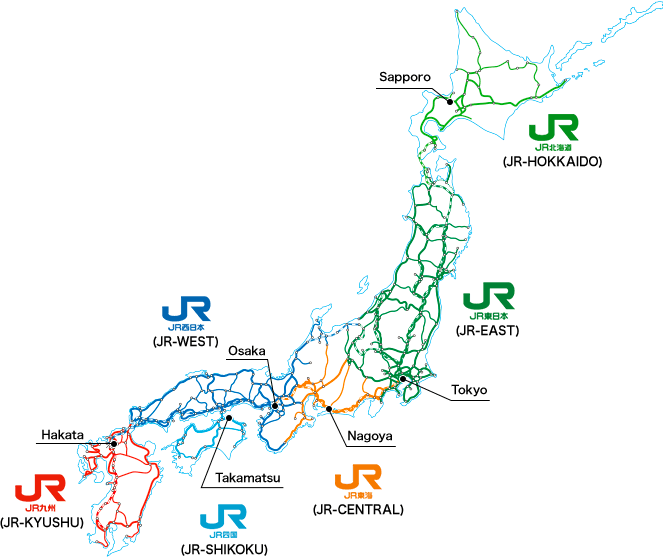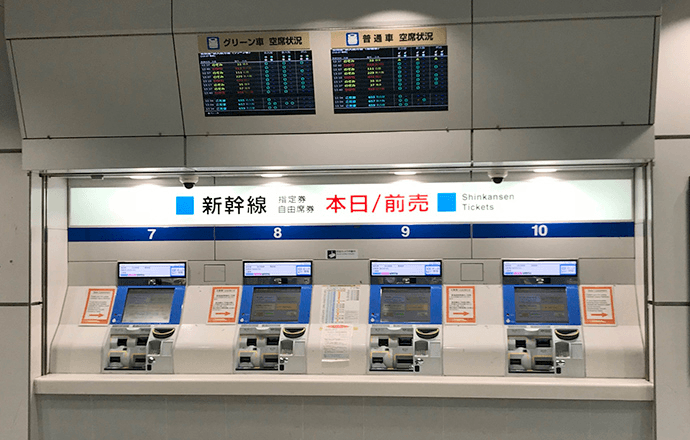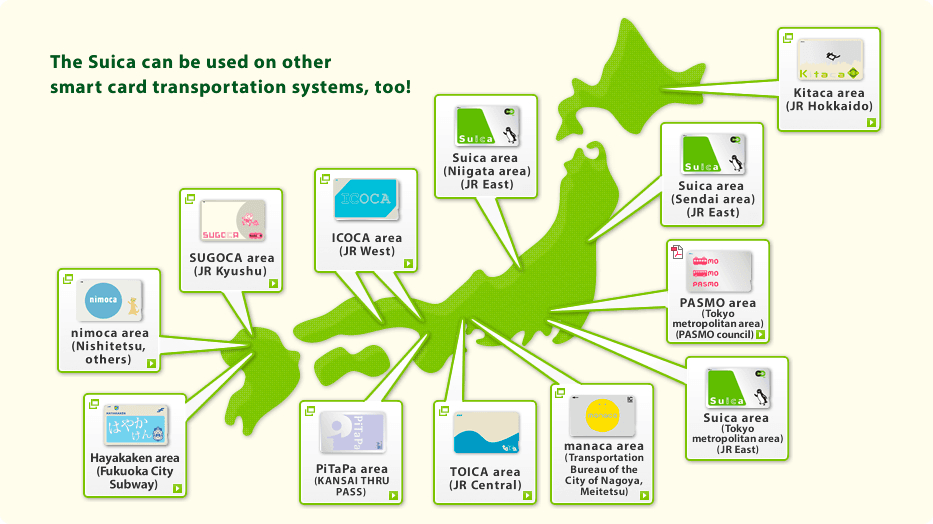Du lịch đường sắt ở Nhật Bản: Hướng dẫn nhanh
Mẹo khám phá Nhật Bản bằng đường sắt
Bản tóm tắt
Nhật Bản là quốc gia tự hào có một số mạng lưới đường sắt hiệu quả, đáng tin cậy và kết nối tốt nhất thế giới. Tuy nhiên, với mạng lưới được điều hành bởi nhiều công ty và mỗi công ty đều có hệ thống bán vé và quy tắc riêng, bạn có thể sẽ cảm thấy khá choáng ngợp nếu lần đầu tiên đến Nhật Bản.
Đường sắt Nhật Bản (JR)
Japan Railways (JR) là mạng lưới đường sắt quốc gia, kết nối các thành phố và thị trấn lớn trên khắp cả nước. Gồm bảy công ty khu vực, tập đoàn JR cung cấp dịch vụ rộng khắp và hiệu quả, chiếm khoảng 80% đường sắt của Nhật Bản và là lựa chọn rất phổ biến cho du khách đến Nhật Bản. Các dịch vụ JR cung cấp kết nối tuyệt vời giữa các thành phố lớn và cũng cung cấp quyền truy cập vào các điểm đến nông thôn hơn trên khắp cả nước.

JR cung cấp nhiều lựa chọn vé, từ vé một lần đi đến vé khu vực và vé nhiều ngày. Vé JR hoặc vé khu vực khá đắt, và mặc dù tiện lợi hơn, nhưng đôi khi bạn có thể mua vé một lần đi tùy thuộc vào kế hoạch chuyến đi của mình.
Khi nào tôi nên cân nhắc mua thẻ JR?
🚆 Bạn sẽ đi du lịch liên thành phố ở Nhật Bản và sẽ thực hiện nhiều chuyến đi đường dài trong một thời gian ngắn
🚆Bạn muốn có sự linh hoạt để đáp ứng nhu cầu đi lại liên thành phố vào phút chót mà không phải tốn thêm chi phí
Thẻ JR có thể không có ý nghĩa khi…
🚆 Bạn sẽ chủ yếu ở lại một thành phố duy nhất
🚆 Các khu vực bạn sẽ đi du lịch không có mạng lưới JR rộng khắp
Làm sao để đánh giá xem thẻ JR có phù hợp với tôi không?
1️⃣ Lên lịch trình sơ bộ cho chuyến đi của bạn: quyết định những khu vực nào của Nhật Bản mà bạn sẽ ghé thăm.
2️⃣ Kiểm tra phạm vi phủ sóng của các loại thẻ đi lại khu vực khác nhau do các công ty khác nhau trong tập đoàn JR cung cấp:
3️⃣ Sau khi xác định được loại vé khu vực (hoặc vé nhiều ngày) phù hợp, hãy so sánh giá với tùy chọn mua vé đơn tại:https://www.jrpass.com/farecomputer/để xác định xem bạn có được hưởng lợi khi mua thẻ JR hay không.
Những cân nhắc khác:
Ngoài các kết nối liên thành phố, bạn cũng có thể muốn cân nhắc các phương thức vận chuyển chính trong mỗi thành phố. Ví dụ, JR pass sẽ rất hữu ích ở các thành phố như Tokyo và Osaka, nhưng ít hữu ích hơn ở Kyoto, nơi xe buýt và các mạng lưới không phải JR phổ biến hơn.
Tôi có thể mua JR Pass ở đâu?
Có nhiều trang web được phép bán vé JR, chẳng hạn nhưhttps://www.jrailpass.com/ hoặc https://www.jrpass.com/. Bạn cũng có thể mua vé trực tiếp từ chính thứcTrang web JR, mặc dù giá của chúng có xu hướng cao hơn. Ngoài ra, bạn có thể mua vé từ một đại lý du lịch địa phương được ủy quyền tại quốc gia của bạn. Cho dù bạn mua trực tuyến hay thông qua một đại lý du lịch, bạn sẽ cần phải đến phòng vé JR khi bạn ở Nhật Bản để đổi lấy thẻ.
Bạn cũng có thể mua vé JR Pass tại phòng vé ở một số nhà ga lớn tại Nhật Bản, nhưng giá thường đắt hơn.
Tôi sử dụng thẻ JR như thế nào?
JR pass là vé của bạn và bạn sẽ có thể sử dụng nó để vào các nhà ga đường sắt. Bạn cũng có thể sử dụng JR pass để đặt chỗ tại các máy bán vé hoặc phòng vé trên khắp Nhật Bản. Nếu bạn mua vé qua trang web chính thức của JR, bạn cũng có thể đặt chỗ trên trang web. Lưu ý rằng bạn bắt buộc phải đặt chỗ cho một số chuyến tàu, vì vậy hãy nhớ kiểm tra trước nếu bạn cần đặt chỗ cho chuyến đi của mình.
Nếu tôi không có thẻ JR thì sao?
Nếu bạn quyết định rằng thẻ JR hoặc thẻ khu vực không phù hợp với mình, bạn vẫn có thể đi tàu bằng cách mua vé một lần trong chuyến đi hoặc mua thẻ IC.
Vé một lượt
Vé một lần là vé bạn có thể mua khi đi lại giữa hai điểm tại Nhật Bản. Tất cả các nhà điều hành tàu hỏa (không chỉ giới hạn ở tàu JR) đều cung cấp tùy chọn mua vé một lần, mặc dù giá vé và quy định có thể khác nhau.
Nhìn chung, bạn có thể mua vé đi một lần tại máy bán vé hoặc quầy bán vé ở nhà ga.

Tại các máy bán vé, chỉ cần chọn ga bạn sẽ đi và điểm đến của bạn, và chọn số lượng vé bạn sẽ mua. Có thể áp dụng thêm phí nếu bạn mua vé toa xanh (thoải mái hơn), tàu tốc hành giới hạn (ít điểm dừng hơn) hoặc nếu bạn có ghế đặt trước.
Nếu bạn đi xa hơn (trên 100km) trên mạng lưới JR, bạn có thể muốn lưu ý rằng vé của bạn cho phép bạn dừng lại nhiều lần tùy ý, miễn là không quay lại và các điểm dừng không nằm trong cùng khu vực với ga khởi hành và ga đến của bạn. Bạn sẽ phải mua vé đặt chỗ ngồi riêng, vé xe xanh và vé tàu tốc hành giới hạn cho từng chặng nếu bạn dừng lại ở nhiều ga khác nhau.
Thẻ IC
Thẻ IC là thẻ trả trước mà bạn có thể nạp tiền và sử dụng cho hầu hết mọi hình thức vận chuyển, và hầu hết không phụ thuộc vào nhà mạng. Thẻ IC rất hữu ích cho giao thông đô thị, đặc biệt là nếu bạn sẽ di chuyển trong một thành phố hoặc khu vực duy nhất.

Có mười loại thẻ IC chính ở Nhật Bản và hầu hết đều giống nhau ngoại trừ việc chúng được phát hành bởi các nhà điều hành khác nhau. Các loại thẻ này có thể được sử dụng trên tàu hỏa và xe buýt do các công ty khác nhau điều hành và có thể được sử dụng thay thế cho nhau ở hầu hết các thành phố lớn trên khắp Nhật Bản. Loại thẻ IC bạn mua chủ yếu phụ thuộc vào khu vực bạn đang ở.
Tuy nhiên, bạn cần lưu ý rằng hành trình của bạn sẽ bị giới hạn bởi phạm vi phủ sóng của thẻ IC — bạn sẽ không thể sử dụng thẻ IC để đi đến những khu vực không có phạm vi phủ sóng. Bạn cũng sẽ không thể sử dụng thẻ IC khi đi lại giữa các khu vực có thẻ IC khác nhau. Nếu bạn chủ yếu ở trong cùng một thành phố hoặc khu vực, thẻ IC sẽ là lựa chọn thuận tiện hơn so với việc mua vé một lần.

Ví dụ, nếu bạn có thẻ SUICA, bạn vẫn có thể sử dụng thẻ này khi đi lại trong Osaka; nhưng bạn sẽ không thể đi từ Tokyo đến Osaka bằng cùng một thẻ vì điều đó được coi là đi lại giữa các khu vực.
Thẻ IC có thể được nạp tiền tại các máy bán vé và cũng có thể được sử dụng để mua hàng tại một số nhà hàng và cửa hàng ở Nhật Bản.
Ngày đi qua

Nếu bạn đi du lịch trong một thành phố duy nhất và mong đợi sử dụng phương tiện giao thông địa phương trong một ngày, bạn cũng có thể cân nhắc đến vé ngày do nhà điều hành phương tiện giao thông địa phương cung cấp. Ví dụ, nếu bạn ở Tokyo, bạn có thể mua vé Tokyo Combination một ngày do tàu điện ngầm Tokyo cung cấp. Các loại vé tương tự cũng được cung cấp bởi các nhà điều hành phương tiện giao thông địa phương tại các thành phố lớn.
Giữ kết nối trên khắp Nhật Bản với eSIM Nomad dành cho Nhật Bản
Giữ kết nối không gặp rắc rối ở Nhật Bản vớieSIM du lịch Nhật Bản từ Nomad. Nomad cung cấpeSIM dữ liệu giá cả phải chăng tại hơn 170 điểm đến trên toàn thế giới, — bao gồm cả Nhật Bản.
Chọn từ nhiều gói dữ liệu địa phương, khu vực và toàn cầu, mua và cài đặt eSIM du lịch trước khi bay và kết nối với mạng cục bộ ngay khi hạ cánh. Hết dữ liệu giữa chuyến đi? Chỉ cần mua tiện ích bổ sung trong ứng dụng Nomad.
Bạn đang có kế hoạch đi du lịch Nhật Bản? Nhận ngayeSIM Nhật Bảnđể giữ liên lạc trong suốt chuyến đi của bạn.